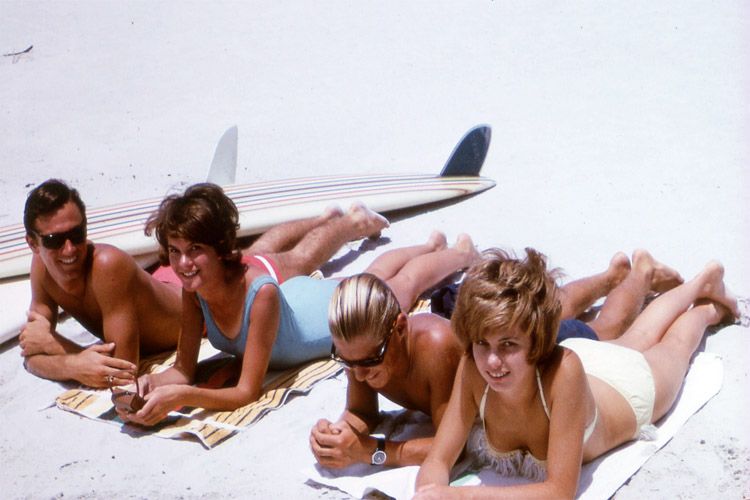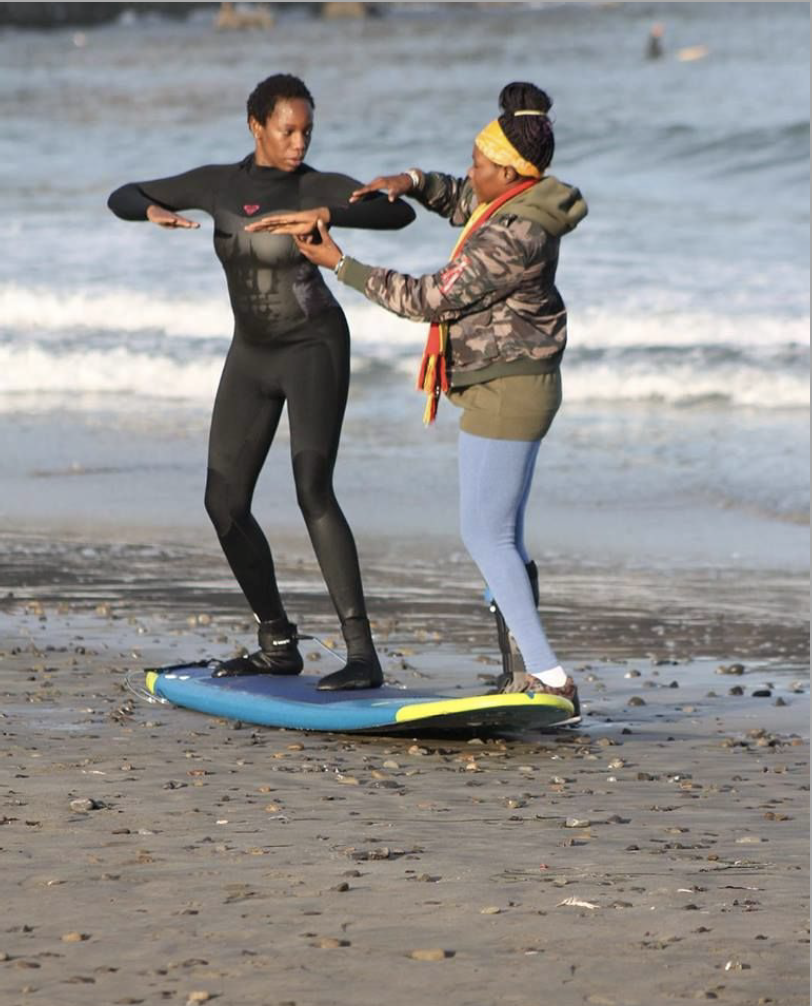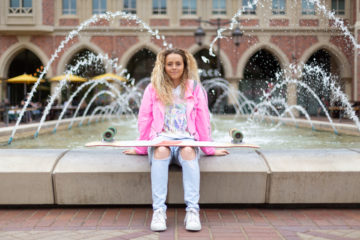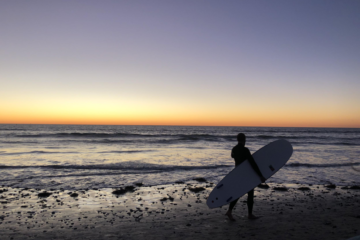These Women Are Working to Change the Stereotype of What a Surfer Looks Like
Throughout the history of American entertainment, there has been a consistent depiction of surfers and of surf culture. While each film’s plot and narrative arcs may differ, the projected image of the surfer has remained the same: young white men. Dating back to films from the late ’50s and early ’60s, such as Surf Party and The Endless Summer, the main characters have always been attractive young white men–and in the case of Gidget, attractive young white women. This trend has continued to recent films such as Lords of Dogtown, Blue Crush and Chasing Mavericks and continues to do so. While this representation may reflect a large portion of the surf community, it does not accurately represent the many diverse faces and voices within that community.

There are people all over the world of different backgrounds, socio-economic classes, races, genders and religion who participate in surfing; however, they are often excluded from the media representation of surf culture and the surf community. The media plays a crucial role in influencing audiences beliefs and defining experiences. Film has the ability to influence, motivate and mobilize audiences and the constant projection of the white male as the only type of surfer can great affect perceptions of the surf community.
Surfing’s origins and early beginnings actually pins back to ancient Polynesian cultures, and it was an integral part of Polynesian culture as a recreational activity. This activity spread to the likes of Hawaii, where the concept of “surfing” was “discovered” by Europeans in the 1700s. One of the most famous and first known surfers, Duke Kahanamoku, was Polynesian and he is generally credited as, “the father of modern surfing,” as he helped spread surfing throughout the world. With this in mind, it is clear that surfing has roots in ethnic backgrounds and was an integral part of different backgrounds and identities. Despite surfing’s historical roots with people of color, it is still heavily regarded as a white sport and this can be attributed to the images constantly projected within the media which suggest this idea. This idea is discussed by author Belinda Wheaton in, “The Cultural Politics of Lifestyle Sports,” as she states:
The quintessential image of the surfing body has, since the 1950s, been ‘phenotypically White’, specifically, a young, white, male subject, slim, toned, tanned—but not ‘too’ dark skinned—with a mop of sun-bleached blonde hair. This image has been perpetuated both in the surfing niche media and most significantly through wider mass media surfing discourses”
In this statement, Wheaton expresses that there has been a precisely crafted representation of the surfer within the media, and this greatly affected conceptions of the surf community and its participants.4 By constantly inundating audiences with the specifically constructed image of the ideal surfer, the media overlooks people with a rich cultural background in surfing and other demographics which participate in the sport. This in turn can allow audiences to associate the sport with one group of people, and ultimately discourage people who do not fit within the construct to participate in surfing.
One group of people in particular who have been largely unrecognized with their participation in surf culture is the African-American community. This can be traced back to the early 1920s were African-Americans faced discrimination and segregation from white people, and not allowed on their beaches. Due to this, they had to carve out spaces for themselves to surf and their participation in surfing was separate and not really discussed. It was not until the 1950s when African-Americans participation in surfing started to become more acknowledged, with the influence of prominent African-American figures such as Nick Gabaldon. Despite Gabaldon’s role in breaking stereotypes and paving the way for more talent African-American surfers, this group of people have continued to remain out of the conversation and unnoticed in the media.
Today, there is still a struggle within the African-American community to make space for themselves and be apart of the conversation in a predominantly white sport and culture of surfing. Organizations such as Black Girl Surf and Brown Girl Surf are working to deconstruct the stereotypical image of the surfer, demystify the notion that surfing is an all white sport and encourage African-American men and women to participate in and join the surf community. Despite the female oriented name of these organizations, they both focus on raising cultural awareness and encouraging diversity in the surf community for all genders and, races, but with a emphasis on women of color because they have been specifically been left out of the surf community representation and narrative.
Brown Girl Surf is working to achieve more diversity and recognition within the community by increasing access to surfing to women of color and creating a community of people of color who surf. The ultimate goal of Brown Girl Surf is to “amplify the voices” of women of color and in turn communicate the message that surfing is a sport that is not exclusive to white men, but is open and encouraging to women of color and something they can also participate and thrive in. Another important aspect of this organization is its emphasis on female empowerment and positive body image. The very few female dominated surf narratives in the media often project the standard image of fit, attractive, young, white women and this is simply not an accurate reflection of all of the different women who engage in the sport. In an online testimonial, a BGS volunteer shared:
I love being a part of BGS because we are leading a larger social movement. Our collective presence in the water is transforming the straight, white male landscape of surfing into one that includes and is defined by us. I have surfed for many years but had always felt like an outsider, because I rarely saw others who looked like me. Even on land, I felt lonely because surf imagery excludes women of color. Not until I joined BGS did I start to feel like I had a place in surfing and the ocean. The sense of collective belonging and self-actualization transcends BGS; it is ingrained into our daily lives.
Brown Girl Surf is not an organization which emphasizes a POC surf community, but instead it is hoping to bring light to all the different women involved in surf and further integrate into the larger surf community. To achieve this BGS hosts events and beach days such as “Surf Sister Saturday,” which bring women of all ages and ethnicities together to get in the water, connect with nature and they even provide surf lessons during these events. A volunteer named Michaela detailed what the events are like and what they mean to the organization: “The event is open to all women and all colors. There is so much strong female power and it is such a supportive environment. No one is shamed or critique based on their level of experience and the best part of these events is all of the positive responses we receive and the women who come back each month to continue in the fun.” In addition, they host fundraisers to make surfing more financially and logistically accessible to women of color.

Similarly the organization Black Girls Surf is working to replace the conventional image of the surfer and reposition the narrative of female surfers. Specifically, Black Girls Surf is working to “change the visual for tomorrow,” by making black women more visible in the professional surfing sphere. This is achieved by creating a community of coaches, mentors and trainers to help allow black women to reach the next level in professional surfing. Rhonda Harper, found of Black Girls Surf, discussed this in a 2018 Surfrider article as she states, “There is no follow up for girls who want to continue up. Black Girls Surf is a way to bridge the gap between surf camps and competing professionally.” Essentially what Harper is trying to do with this organization is give young black women and women of color the tools and resources to succeed in the professional surf sphere and give them the opportunity to reach the next level. A volunteer for Black Girls Surf further touched upon this in a personal interview as she stated:
There are so many young women passionate about the sport, but they lack the proper resources in order to go to the next level. To be the next Keely Andrew or Stephanie Gilmore. BGS is a safe haven for young women of all colors to go for their dreams and work hard to accomplish their goals. We want to show that this is not just a white sport, and only white people can make it to the next professional level. While there have been some people of color who have made it to the next level there has not been enough and our mission is to bring more faces and more diversity into professional surfing.
Black Girls Surf emphasizes a commitment to giving young women of color access to the ocean, and all the necessities they would need to move forward in surfing. This is a impactful way of reinforcing the diverse faces in surfing as well as flipping the constructed narrative about surf culture and community. In addition, Black Girls Surf represents professional athletes all around the world and provides them with the financials means and support to continue competing and training to get to the next level.
Both Black Girls Surf and Brown Girl Surf present a positive message about representation in surf culture and creating a platform for these voices to be heard and recognized. Both of these organizations are not looking to be inclusive to people of color and focus only on creating a community of people of color, rather they want to spread awareness of all the different shapes, stories, races and genders involved in the sport, encourage more people of color to surf and make it more commonplace to see people of color in media representations about surfing.


